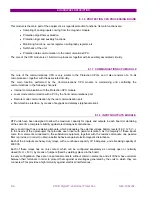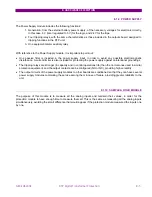
4. FUNCTIONS DESCRIPTION
4-6
DTP-B Digital Transformer Protection
GEK-106243E
4.6 HUMAN-MACHINE INTERFACE (MMI).
The DTP unit includes as standard a 20 key keyboard and a 2-line liquid crystal display (LCD) with 16 characters
per line. This display has highly reliable LED diode back lighting (the screen brightness can be adjusted on the
rear of the front board).
By means of this interface the user can change the settings, visualize measurements, carry out operations and
access information stored in the unit. The functions of this local interface and how to use it are described in the
section KEYBOARD AND DISPLAY.
4.7 REMOTE COMMUNICATIONS
The relay has 2 serial gates and three connectors. Gate 1 can be reached from the front of the relay in connector
1 (PORT 1 connector) or from the back (PORT 2 connector). The second gate can be reached from connector 3
(PORT 3 connector) which is located on the rear.
There are different models each with a different physical connection for the PORT 3 connector (RS-232, RS-485
or fiber-optic). In the "RS232" models the three connectors are RS232. In the “RS232 and RS485” models,
PORT1 and PORT2 are RS232, while PORT3 is RS485. In the "RS232 and fiber-optic" models the PORT1 and
PORT2 connectors are RS232 while the PORT3 connector is replaced by a fiber-optic connector.
PORT 1 connector has priority over PORT 2 connector and is selected when the DCD (Data Carrier Detect) signal
is activated. Figure 3 illustrates how to make the connections to a personal computer.
Gate 1 (PORT 1 and PORT 2 connectors) and 2 (PORT 3 connector) are independent and the unit can serve
them simultaneously.
The communications protocol (MLINK) is the same as that used for the rest of the DDS System GE Digital
Protections, and requires the use of the GE-LOCAL software. The protocol is reliable and allows communication
with different protection systems. It guarantees very efficient data transfer (especially for the oscillography and
other large files) along with error detection and automatic communication recovery.
The status of the local/remote communication is indicated on the front of the unit by LED indicator 16 (the last
LED in the right-hand column.) Local communication refers to communication via the keyboard/display (local
display showing any information except for the initial DTP GENERAL ELECTRIC screen), or via communications
gate 1 (PORT 1, PORT2 connectors), and remote communication refers to connection via gate 2 (PORT 3 rear
connector), or when in the initial DTP GENERAL ELECTRIC screen, PORT1 is not connected.
Local and remote communications can exist at the same time, although there is only one possibility for changing
settings and carrying out operations, since this can only be done with the communication which has priority (local
communication) while the other is limited only to accessing information. When the local communication is
interrupted, either by the disconnection of PORT 1 connector or because the MMI is on the initial screen (a
situation which can be caused intentionally, or automatically if no key has been pressed for 15 minutes), the
remote communication recovers the ability to modify settings and carry out operations.
The unit can implement a different protocol, apart from MLINK. In this case, the relay communicates using MLINK
by PORT1 (connectors 1 and 2), and the other protocol uses PORT2.
Summary of Contents for DTP-B
Page 23: ...3 OPERATING PRINCIPLES 3 6 DTP B Digital Transformer Protection GEK 106243E ...
Page 53: ...10 INSTALLATION AND MAINTENANCE 10 2 DTP B Digital Transformer Protection GEK 106243E ...
Page 68: ...12 FIGURES GEK 106243E DTP Digital Transformer Protection 12 3 Figure 3 RS 232 Connection ...
Page 69: ...12 FIGURES 12 4 DTP B Digital Transformer Protection GEK 106243E Figure 4 Dimensions Diagram ...
Page 70: ...12 FIGURES GEK 106243E DTP Digital Transformer Protection 12 5 Figure 5 Front View ...
















































